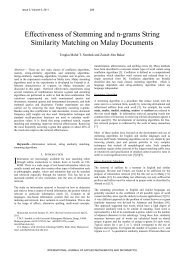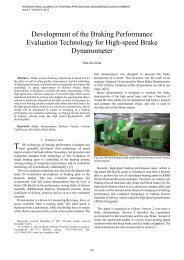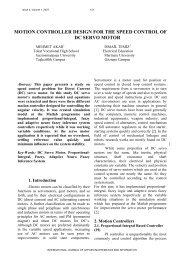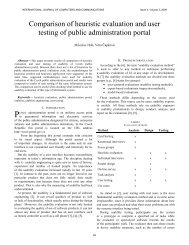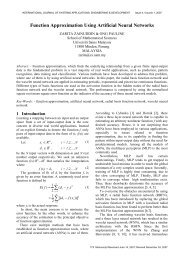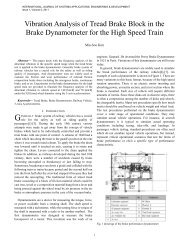Using MODIS 250 m Imagery to Estimate Total Suspended Sediment
Using MODIS 250 m Imagery to Estimate Total Suspended Sediment
Using MODIS 250 m Imagery to Estimate Total Suspended Sediment
You also want an ePaper? Increase the reach of your titles
YUMPU automatically turns print PDFs into web optimized ePapers that Google loves.
INTERNATIONAL JOURNAL OF SYSTEMS APPLICATIONS, ENGINEERING & DEVELOPMENTIssue 1, Volume 3, 2009III. RESULTS AND DISCUSSIONFigure 2. Schematic illustration of two methods used <strong>to</strong>process <strong>MODIS</strong> data. Method 1 is based in ENVI imageprocessing software and Method 2 uses SeaDAS specializedcommands.this number was limited <strong>to</strong> five for the second equation. Thisdifference was mainly due <strong>to</strong> the lack of good quality imagessuitable for analyses, which affected the development of thesecond equation. <strong>MODIS</strong> reflectance values were extractedfrom pixels corresponding <strong>to</strong> stations moni<strong>to</strong>red for R rs .Developed equations were applied <strong>to</strong> two images (February12, 2004 & March 8, 2008), which were not incorporated inthe previous analysis and in situ data were available in order<strong>to</strong> validate developed algorithms. Application of theequations was possible using ENVI band math <strong>to</strong>ol, whichcontains easy <strong>to</strong> use options <strong>to</strong> ingrate image bands inmathematical equations.Proficiency of the algorithms was evaluated by comparingestimated and observed values in a root mean square error(RMSE) analysis. Additionally, obtained TSS products werevisually analyzed in order <strong>to</strong> evaluate and identify spatialpatterns associated <strong>to</strong> this type of environment. Finally,resultant values corresponding <strong>to</strong> Mayagüez Bay area wereextracted for statistical analyses. The Mayagüez Bay area wasdigitalized by visual interpretation using orthorectified aerialpho<strong>to</strong>graph (2006) and saved as a polygon shapefile (ArcGIS9.3, ESRI). This shapefile was then imported <strong>to</strong> ENVI usingits vec<strong>to</strong>r files menu options and converted <strong>to</strong> a Region ofInterest (ROI), from which was very simple <strong>to</strong> extract theinformation of all pixels in the area of interest.A. <strong>MODIS</strong> ProductsThe first method resulted on seven reflectance products at645 nm (band 1), one for each research cruise dates. Threedifferent products for each date were generated using thesecond method: Remote sensing reflectance (R rs ), LeavingWater Radiance (L w ) and Normalized Leaving Radiance(nL w ). For purposes of this study the target product was R rs at645 nm, however resultant values in this and the rest ofgenerated products were mostly negative and with flaggedvalues. This suggested that the standard method forprocessing <strong>MODIS</strong> data in SeaDAS is not suitable forapplication in this type of waters characterized by highconcentrations of TSS and other water constituents incomparison <strong>to</strong> oceanic waters. Low and negative valuesindicated that the applied atmospheric correction it removedalso part of the water leaving signal while flag values in thecoast suggest that the algorithm is identifying as errors highlycontrasting reflectance values. Variations between Case 1 andCase 2 water limits generation of standard satellite products[19]. These processing algorithms are mainly developed foroceanic waters applications, therefore they are not able <strong>to</strong>recognize as good values, patterns that are typical in coastalwaters. One potential option <strong>to</strong> minimize the number of flagvalues is <strong>to</strong> adjust the different parameters available in theflags menu option within the L2gen command, but thisapproach is not included in this analysis. Table 2 showsreflectance values and in situ R rs 645 nm values obtained inlocations of sampling stations during Oc<strong>to</strong>ber 19, 2005. Thesatellite derived reflectance is considerably lower than in situR rs suggesting a significant effect of atmospheric scattering inthe signal.Stat.IDLatitude(N)Longitude(W)Method 1Reflectanceat 645 nmin situR rs at645 nmI1 18º 16.00’ 67º 12.00’ 0.047406 0.0130O1 18º 16.00’ 67º 15.20’ 0.018792 0.00118I2 18º 14.40’ 67º 11.40’ 0.027528 0.0041O2 18º 14.40’ 67º 11.40’ 0.019948 0.0007O4 18º 12.20’ 67º 12.95’ 0.016265 0.0005I6 18º 10.25’ 67º 11.10’ 0.027037 0.0081O6 18º 10.25’ 67º 14.80’ 0.014844 0.0005Table 2. Pixel values obtained in permanent sampling stationsusing two different image processing methods and in situ R rsat 645 nm.B. <strong>Total</strong> <strong>Suspended</strong> <strong>Sediment</strong> AlgorithmA significant relationship (R 2 =0.73; n=72) was definedbetween TSS (mg/l) and in situ R rs at 645 (Fig. 3a). Thisresult suggests that this region of the spectrum is suitable forTSS estimation using remotely sensed data in these waters.However, a large unknown variability was detected in thisequation that could be reduced by the incorporation of more38



